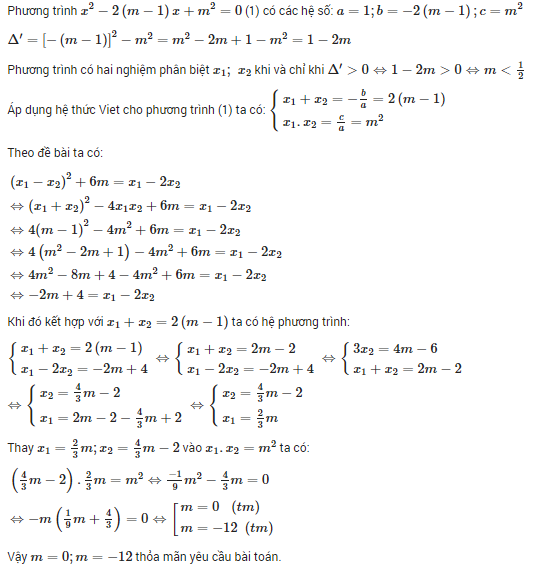Hãy nhập câu hỏi của bạn vào đây, nếu là tài khoản VIP, bạn sẽ được ưu tiên trả lời.

\(\Delta=\left(-m\right)^2-2.1.\left(m-1\right)\\ =m^2-2m+1\\ =\left(m-1\right)^2\)
Phương trình có hai nghiệm phân biệt :
\(\Leftrightarrow\Delta>0\\ \Rightarrow\left(m-1\right)^2>0\\ \Rightarrow m\ne1\)
Theo vi ét :
\(\Leftrightarrow\left\{{}\begin{matrix}x_1+x_2=m\\x_1x_2=m-1\end{matrix}\right.\)
\(x^2_1+x^2_2=x_1+x_2\\ \Leftrightarrow x^2_1+x^2_2=m\\ \Leftrightarrow\left(x^2_1+2x_1x_2+x_2^2\right)-2x_1x_2=m\\ \Leftrightarrow\left(x_1+x_2\right)^2-2x_1x_2-m=0\\ \Leftrightarrow m^2-2\left(m-1\right)-m=0\\ \Leftrightarrow m^2-2m+2-m=0\\ \Leftrightarrow m^2-3m+2=0\\ \Leftrightarrow\left[{}\begin{matrix}m=1\left(loại\right)\\m=2\left(t/m\right)\end{matrix}\right.\)
Vậy \(m=2\)

Em ko ghi đc dấu căn nên em đóng ngoặc nghĩa là cả cụm đó dưới dấu căn

\(\Delta'=1-\left(m-3\right)=4-m>0\Rightarrow m< 4\)
Theo hệ thức Viet: \(\left\{{}\begin{matrix}x_1+x_2=2\\x_1x_2=m-3\end{matrix}\right.\)
Do \(x_1+x_2=2\Rightarrow x_2=2-x_1\)
Ta có:
\(x_1^2+x_1x_2=2x_2-12\)
\(\Leftrightarrow x_1\left(x_1+x_2\right)=2\left(2-x_1\right)-12\)
\(\Leftrightarrow2x_1=4-2x_1-12\)
\(\Leftrightarrow4x_1=-8\Rightarrow x_1=-2\Rightarrow x_2=4\)
Thế vào \(x_1x_2=m-3\Rightarrow m-3=-8\)
\(\Rightarrow m=-5\)

∆ = m² - 4(m - 5)
= m² - 4m + 5
= (m² - 4m + 4) + 1
= (m - 2)² + 1 > 0 với mọi m
Phương trình luôn có 2 nghiệm phân biệt
Theo Viét ta có:
x₁ + x₂ = m (1)
x₁.x₂ = m - 5 (2)
x₁ + 2x₂ = 1 (3)
Lấy (3) - (1) ta được x₂ = 1 - m thay vào (1) ta được
x₁ + 1 - m = m
⇔ x₁ = 2m - 1
Thay x₁ = 2m - 1 và x₂ = 1 - m vào (2) ta được:
(2m - 1)(1 - m) = m - 5
⇔ 2m - 2m² - 1 + m - m + 5 = 0
⇔ -2m² + 2m + 5 = 0
∆ = 4 - 4.(-2).5
= 44
m₁ = -1 + √11
m₂ = -1 - √11
Vậy m = -1 + √11; m = -1 - √11 thì phương trình đã cho có hai nghiệm thỏa mãn x₁ + 2x₂ = 1

\(\Delta=1-4\left(-m-2\right)\ge0\Leftrightarrow m\ge-\dfrac{9}{4}\)
Theo hệ thức Viet: \(\left\{{}\begin{matrix}x_1+x_2=-1\\x_1x_2=-m-2\end{matrix}\right.\)
\(x_1^2-x_1x_2-2x_2=16\)
\(\Leftrightarrow x_1\left(x_1+x_2\right)-2x_1x_2-2x_2=16\)
\(\Leftrightarrow-x_1-2\left(-m-2\right)-2x_2=16\)
\(\Leftrightarrow x_1+2x_2=2m-12\)
\(\Rightarrow x_1+x_2+x_2=2m-12\)
\(\Leftrightarrow-1+x_2=2m-12\Rightarrow x_2=2m-11\Rightarrow x_1=-1-x_2=-2m+10\)
Lại có: \(x_1x_2=-m-2\)
\(\Rightarrow\left(-2m+10\right)\left(2m-11\right)=-m-2\)
\(\Leftrightarrow4m^2-43m+108=0\Rightarrow\left[{}\begin{matrix}m=4\\m=\dfrac{27}{4}\end{matrix}\right.\)

\(\Delta=1-4\left(m+1\right)>0\Rightarrow m< -\dfrac{3}{4}\)
Khi đó theo hệ thức Viet: \(\left\{{}\begin{matrix}x_1+x_2=1\\x_1x_2=m+1\end{matrix}\right.\)
\(x_1^2+x_1x_2+3x_2=7\)
\(\Leftrightarrow x_1\left(x_1+x_2\right)+3x_2=7\)
\(\Leftrightarrow x_1+3x_2=7\)
Kết hợp Viet ta được: \(\left\{{}\begin{matrix}x_1+x_2=1\\x_1+3x_2=7\end{matrix}\right.\) \(\Rightarrow\left\{{}\begin{matrix}x_1=-2\\x_2=3\end{matrix}\right.\)
Thế vào \(x_1x_2=m+1\)
\(\Rightarrow m+1=-6\Rightarrow m=-7\)

Phương trình có hai nghiệm phân biệt x1, x2 ⇔ ∆ = 52 – 4(3m + 1) > 0 ⇔ 21 – 12m > 0
ó m < 21/12
Với m < 21/12 , ta có hệ thức x 1 + x 2 = 5 x 1 x 2 = 3 m + 1 V i e t '
⇒ | x 1 − x 2 | = ( x 1 − x 2 ) 2 = ( x 1 + x 2 ) 2 − 4 x 1 x 2 = 5 2 − 4 ( 3 m + 1 ) = 21 − 12 m = > | x 1 2 − x 2 2 | = | ( x 1 + x 2 ) ( x 1 − x 2 ) | = | 5 ( x 1 − x 2 ) | = 5 | x 1 − x 2 | = 5 21 − 12 m
Ta có: | x 1 2 − x 2 2 | = 15 ⇔ 5 21 − 12 m = 15 ⇔ 21 − 12 m = 3 ⇔ 21 − 12 m = 9 ⇔ 12 m = 12 ⇔ m = 1 (t/m)
Vậy m = 1 là giá trị cần tìm

Để pt có 2 nghiệm phân biệt thì \(\Delta>0\)
\(\Rightarrow m^2-4.1.\left(-2\right)>0\\ \Rightarrow m^2+8>0\left(luôn.đúng\right)\)
Vậy pt luôn có 2 nghiệm phân biệt
Áp dụng định lý Vi-ét ta có:\(\left\{{}\begin{matrix}x_1+x_2=-m\\x_1x_2=-2\end{matrix}\right.\)
\(x^2_1x_2+x_1x^2_2=2021\\ \Leftrightarrow x_1x_2\left(x_1+x_2\right)=2021\\ \Leftrightarrow\left(-m\right)\left(-2\right)=2021\\ \Leftrightarrow2m=2021\\ \Leftrightarrow m=\dfrac{2021}{2}\)
Để pt có 2 nghiệm thì
\(\Delta>0\\ \Rightarrow m^2-4.1.\left(-2\right)>0\\ \Rightarrow m^2+8>0.đúng.\forall.m\)
Vậy pt luôn có 2 nghiệm phân biệt
Áp dụng đlí Viét ta có
\(\left\{{}\begin{matrix}x_1+x_2=\dfrac{-b}{a}=-m\\x_1x_2=\dfrac{c}{a}=-2\end{matrix}\right.\)
Lại có
\(x_1x_2+x_1x_2=2021\\ \Rightarrow x_1x_2\left(x_1+x_2\right)< 2021\\ \Rightarrow-2\left(-m\right)=2021\Rightarrow2m=2021\\ \Rightarrow m=\dfrac{2021}{2}\)